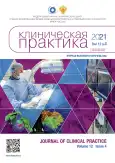A clinical case of successful treatment of a giant serous endometrial carcinoma imitating ovarian cancer
- Authors: Berishvili A.I.1, Ivanov Y.V.1, Lebedev D.P.1, Zabozlaev F.G.1, Kravchenko E.V.1, Klypa T.V.1, Kedrova A.G.1
-
Affiliations:
- Federal Scientific and Clinical Center for Specialized Medical Assistance and Medical Technologies
- Issue: Vol 12, No 4 (2021)
- Pages: 80-85
- Section: Case reports
- URL: https://journals.rcsi.science/clinpractice/article/view/90662
- DOI: https://doi.org/10.17816/clinpract90662
- ID: 90662
Cite item
Full Text
Abstract
Background: Giant tumors of the abdominal cavity, as a rule, occur in elderly patients with characteristic features and represent a serious problem in terms of choosing a radical method of therapy. Of particular difficulty are cases of giant serous endometrial cancer, requiring a differential diagnosis with ovarian cancer.
Clinical case description: A clinical case of giant serous endometrial cancer mimicking ovarian cancer in a 55-year-old woman is presented. The patient came to the oncology department with complaints of abdominal enlargement, difficulty breathing and bloody discharge from the genital tract. The examination revealed the following: a giant formation (40×65 cm), occupying the entire pelvic and the entire abdominal cavities, ascites, lesions of the retroperitoneal lymph nodes, and the greater omentum, an umbilical hernia. A chest CT showed multiple contrast-accumulating circular shadows of 3–13 mm (metastases). By the decision of the council, after the preliminary chemoembolization of both the uterine and ovarian arteries, a supravaginal amputation of the uterus with appendages was performed, along with the resection of the greater omentum, removal of the umbilical hernia with positioning a plastic mesh implant and excision of an excess skin flap. The histological examination of the intraoperative material made it possible to verify the diagnosis of a serous endometrial carcinoma with subtotal tumor necrosis, the myometrium invasion of more than a half of its thickness, with the egress to the perimetrium, metastatic lesions of both ovaries, the greater omentum, anterior abdominal wall. Stage T3b (FIGO IIIB). In the postoperative period, 6 courses of Paclitaxel / Carboplatin (AUC4-5) chemotherapy were carried out with a pronounced clinical effect. The patient was discharged in a satisfactory condition. The control PET-CT scan after the 6th chemotherapy course showed no pathology in the thoracic cavity, and no process progress in the abdominal cavity. Currently, the remission of the disease is 9 months.
Conclusion: An algorithm for the diagnostic measures aimed at making the correct diagnosis is presented, and the tactics of treating a patient with giant serous endometrial cancer is described.
Keywords
Full Text
##article.viewOnOriginalSite##About the authors
Aleksander I. Berishvili
Federal Scientific and Clinical Center for Specialized Medical Assistance and Medical Technologies
Author for correspondence.
Email: aberishvili@yandex.ru
SPIN-code: 1828-6147
M.D., Ph.D., Dr. Sci. (Med.), Professor
Russian Federation, 28, Orechovy boulevard, Moscow, 115682Yuri V. Ivanov
Federal Scientific and Clinical Center for Specialized Medical Assistance and Medical Technologies
Email: ivanovkb83@yandex.ru
ORCID iD: 0000-0001-6209-4194
SPIN-code: 3240-4335
M.D., Ph.D., Dr. Sci. (Med.), Professor
Russian Federation, 28, Orechovy boulevard, Moscow, 115682Dmitry P. Lebedev
Federal Scientific and Clinical Center for Specialized Medical Assistance and Medical Technologies
Email: lebedevdp@gmail.com
ORCID iD: 0000-0003-1551-3127
SPIN-code: 4770-5722
Russian Federation, 28, Orechovy boulevard, Moscow, 115682
Fedor G. Zabozlaev
Federal Scientific and Clinical Center for Specialized Medical Assistance and Medical Technologies
Email: fzab@mail.ru
ORCID iD: 0000-0002-7445-8319
SPIN-code: 3259-9332
M.D., Ph.D., Dr. Sci. (Med.)
Russian Federation, 28, Orechovy boulevard, Moscow, 115682Edward V. Kravchenko
Federal Scientific and Clinical Center for Specialized Medical Assistance and Medical Technologies
Email: patan-st@mail.ru
Russian Federation, 28, Orechovy boulevard, Moscow, 115682
Tatiana V. Klypa
Federal Scientific and Clinical Center for Specialized Medical Assistance and Medical Technologies
Email: tvklypa@gmail.com
ORCID iD: 0000-0002-2732-967X
SPIN-code: 2349-8980
M.D., Ph.D., Dr. Sci. (Med.)
Russian Federation, 28, Orechovy boulevard, Moscow, 115682Anna G. Kedrova
Federal Scientific and Clinical Center for Specialized Medical Assistance and Medical Technologies
Email: kedrova.anna@gmail.com
ORCID iD: 0000-0003-1031-9376
SPIN-code: 3184-9760
M.D., Ph.D., Dr. Sci. (Med.)
Russian Federation, 28, Orechovy boulevard, Moscow, 115682References
- Charo LM, Plaxe SC. Recent advances in endometrial cancer: a review of key clinical trials from 2015 to 2019. F1000Res. 2019;8:F1000. Faculty Rev-849. doi: 10.12688/f1000research.17408.1
- Siegel RL, Miller KD, Jemal A. Cancer statistics, 2019. CA Cancer J Clin. 2019;69(1):7–34. doi: 10.3322/caac.21551
- Miller D, Filiaci V, Fleming G, et al. Late-breaking abstract 1: Randomized phase III noninferiority trial of first line chemotherapy for metastatic or recurrent endometrial carcinoma: A Gynecologic Oncology Group study. Gynecol Oncol. 2012;125(3):771. doi: 10.1016/j.ygyno.2012.03.034
- Hamilton CA, Cheung MK, Osann K, et al. Uterine papillary serous and clear cell carcinomas predict for poorer survival compared to grade 3 endometrioid corpus cancers. Br J Cancer. 2006;94(5):642–646. doi: 10.1038/sj.bjc.6603012
- Rungruang B, Olawaiye AB. Comprehensive surgical staging for endometrial cancer. Rev Obstet Gynecol. 2012; 5(1):28–34.
- Bestvina CM, Fleming GF. Chemotherapy for endometrial cancer in adjuvant and advanced disease settings. Oncologist. 2016;21(10):1250–1259. doi: 10.1634/theoncologist.2016-0062
- Fader AN, Roque DM, Siegel E, et al. Randomized phase II trial of carboplatin-paclitaxel versus carboplatin-paclitaxel-trastuzumab in uterine serous carcinomas that overexpress human epidermal growth factor receptor 2/neu. J Clin Oncol. 2018;36(20): 2044–2051. doi: 10.1200/JCO.2017.76.5966
- Shaeffer DT, Randall ME. Adjuvant radiotherapy in endometrial carcinoma. Oncologist. 2005;10(8):623–631. doi: 10.1634/theoncologist.10-8-623
- Le Gallo M, Bell DW. The emerging genomic landscape of endometrial cancer. Clin Chem. 2014;60(1):98–110. doi: 10.1373/clinchem.2013.205740
- Lokich E, Kole M, Raker C, et al. Molecular markers in uterine serous cancer: Correlation between endometrial biopsy and hysterectomy specimens. Gynecol Oncol Rep. 2019;29:98–101. doi: 10.1016/j.gore.2019.04.005
- Schwab CL, Santin AD. Targeted therapy in the treatment of uterine serous carcinoma. Pharmacogenomics. 2015;16(2):97–99. doi: 10.2217/pgs.14.176
- Meng X, Laidler LL, Kosmacek EA, et al. Induction of mitotic cell death by overriding G2/M checkpoint in endometrial cancer cells with non-functional p53. Gynecol Oncol. 2013; 128(3):461–469. doi: 10.1016/j.ygyno.2012.11.004
- Houghton PJ. Everolimus. Clin Cancer Res. 2010;16: 1368–1372. doi: 10.1158/1078-0432.CCR-09-1314
- Barrington DA, Dilley SE, Smith HJ, Straughn JM. Pembrolizumab in advanced recurrent endometrial cancer: A cost-effectiveness analysis. Gynecol. Oncol. 2019;153(2):381–384. doi: 10.1016/j.ygyno.2019.02.013
Supplementary files








